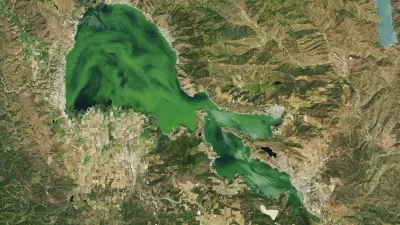Scientists hope to use AI and machine learning models to forecast water quality issues caused by toxic blue-green algae blooms.

According to the Los Alamos Reporter, scientists from the Los Alamos National Laboratory plan to use artificial intelligence modeling to forecast toxic algal blooms, which “[f]ueled by climate change and rising water temperatures … have grown in intensity and frequency” and “have now been reported in all 50 U.S. states.” Perhaps the most well-known occurrence of these harmful algal blooms, or HABs, happened in 2014, when dangerous toxin levels in Lake Erie forced Toledo, Ohio, to shut down the drinking water supply of a half-million residents for three days. Just last month, Clear Lake in California was in the news for its own blue-green algal bloom, which some fear will impact summer tourism activities.
“For decades, scientists have understood that elevated water temperatures, combined with sudden infusions of nutrients (often phosphorous and nitrogen runoff from industrial farming), tend to precede a HAB event …. But what causes toxic cyanobacteria to prevail in these freshwater ecosystems has proved challenging to understand” because they are “complex ecosystems influenced by hundreds — sometimes thousands — of other microorganisms,” the Los Alamos Reporter article reads. Armed with masses of data on HABs collected since 1954 by a variety of organizations across the nation and the world, the scientists plan to feed existing yet disparate information into a data learning model and use AI to decipher and analyze it.
“Such a model could then be used to forecast algal blooms, and possibly even predict how climate change will alter their intensity and frequency in the future,” said Babetta Marrone, senior scientist at the LANL and the project’s team lead, in a press release.
FULL STORY: LANL: AI Can Help Forecast Toxic ‘Blue-Green Tides’

Alabama: Trump Terminates Settlements for Black Communities Harmed By Raw Sewage
Trump deemed the landmark civil rights agreement “illegal DEI and environmental justice policy.”

Planetizen Federal Action Tracker
A weekly monitor of how Trump’s orders and actions are impacting planners and planning in America.

The 120 Year Old Tiny Home Villages That Sheltered San Francisco’s Earthquake Refugees
More than a century ago, San Francisco mobilized to house thousands of residents displaced by the 1906 earthquake. Could their strategy offer a model for the present?

In Both Crashes and Crime, Public Transportation is Far Safer than Driving
Contrary to popular assumptions, public transportation has far lower crash and crime rates than automobile travel. For safer communities, improve and encourage transit travel.

Report: Zoning Reforms Should Complement Nashville’s Ambitious Transit Plan
Without reform, restrictive zoning codes will limit the impact of the city’s planned transit expansion and could exclude some of the residents who depend on transit the most.

Judge Orders Release of Frozen IRA, IIJA Funding
The decision is a victory for environmental groups who charged that freezing funds for critical infrastructure and disaster response programs caused “real and irreparable harm” to communities.
Urban Design for Planners 1: Software Tools
This six-course series explores essential urban design concepts using open source software and equips planners with the tools they need to participate fully in the urban design process.
Planning for Universal Design
Learn the tools for implementing Universal Design in planning regulations.
Clanton & Associates, Inc.
Jessamine County Fiscal Court
Institute for Housing and Urban Development Studies (IHS)
City of Grandview
Harvard GSD Executive Education
Toledo-Lucas County Plan Commissions
Salt Lake City
NYU Wagner Graduate School of Public Service





























